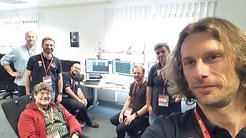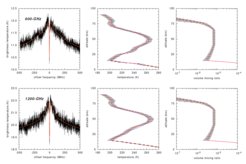A taste of solar wind and a glimpse of Earth
The MPS instruments on board ESA’s JUICE spacecraft have successfully completed their commissioning in space - and delivered their first observational data.
About three months after the launch of ESA's JUICE spacecraft, the scientific instruments that the Max Planck Institute for Solar System Research (MPS) in Germany is sending along on the long journey to Jupiter have completed their first tasks in space. Both instruments have proven that they are fully functional under space conditions and have sent their first scientific data back to Earth: the Particle Environment Package's (PEP) Jovian Electron and Ion Sensor (JEI) "tasted" particles of the solar wind, and the Submillimeter Wave Instrument (SWI) identified water in Earth's atmosphere. For SWI in particular, however, the first steps in space went quite differently than expected.

When the 16-meter antenna boom of the JUICE’s instrument Radar for Icy Moon Exploration (RIME) failed to deploy a few days after the successful rocket launch in mid-April, the first adventure on the way to Jupiter also began for the SWI team. "Parts of SWI and RIME are located in close proximity to each other aboard the spacecraft; it was therefore clear, that both instruments would face the upcoming challenges together”, said Dr. Ali Ravanbakhsh of the MPS, SWI project manager. As a result, the efforts by ESA and the RIME team to solve the antenna's jammed locking pin also had an impact on SWI. "All steps had to be well considered from our side as well. That's why it was necessary to get SWI up and running much earlier than planned," said MPS scientist Dr. Paul Hartogh, Principal Investigator of the SWI team. Normally, the plan for the steps in which an instrument will be turned on, commissioned and tested is set months in advance; now everything was different - and had to happen much faster.
In addition, SWI was faced with requirements that were not originally foreseen. To thaw any ice on the jammed RIME mechanism, ESA opted to turn the spacecraft toward the Sun. "Such a maneuver at such close distance to the Sun was never part of the mission plan," Hartogh said. To be sure SWI would not be damaged, the SWI team had to model as quickly as possible how the instrument would react to the strong solar radiation - and was able to give the green light for the maneuver. When the RIME antenna was finally released on May 12, it was relieving news for the SWI team as well. "We are very pleased that we were able to support our colleagues from ESA and the RIME team, and that JUICE will now be able to realize its full scientific potential in the Jupiter system," Ravanbakhsh said.
Cautious approach

Despite the urgency required and the tight schedules, an instrument commissioning is always a gradual, cautious process. "The instrument has to prove itself for the first time in a real space setting. You don't want to take any risks and therefore approach full operating mode only carefully," said MPS scientist Dr. Markus Fränz of the PEP-JEI team. For example, gas residues from the construction of the probe, which gradually outgas in space, could cause voltage flashovers in the JEI sensor and damage the instrument. The team therefore first increased and decreased the voltages with which the sensor is operated very gradually at first. With success: In the meantime, the commissioning of PEP-JEI has been completed; the sensor was able to demonstrate its capabilities at low and medium voltages. For safety reasons, PEP-JEI will not be operated at the highest voltages until January 2024. PEP's other five sensors have also successfully completed commissioning.
Already, PEP-JEI has obtained first scientific data: protons and alpha particles from the solar wind have been detected. The steady stream of particles from the Sun constantly flows around the JUICE spacecraft on its way to Jupiter. "Since PEP does not look directly in the direction of the incoming solar wind, we had not necessarily expected to see the solar wind in our data," said MPS scientist Dr. Norbert Krupp. "Nevertheless, due to the large velocity difference between the probe and the solar wind, some particles reach our sensor. Now we know that our instrument works in space," he adds.

SWI was able to make its first measurements,too. On July 8th, SWI recorded the first spectra of water vapor from Earth's atmosphere from a distance of about 22 million kilometers. The data can be used to derive information about the temperature profile and altitude distribution of water vapor. "The latest observational data from SWI show us how sensitively the instrument measures. We therefore expect to be able to detect water vapor in Jupiter's atmosphere from a distance of at least 250 million kilometers," Hartogh said.
"Despite the extensive testing that all instruments undergo before mission launch, commissioning in space is always a kind of learning process," said MPS scientist Dr. Elias Roussos, who oversaw the commands sent to PEP-JEI by ESA's control center in Darmstadt, Germany. "We are getting to know our instrument all over again." There is still plenty of time to make any minor adjustments that may be needed. It won't be until January of next year that the SWI and PEP-JEI teams will have another opportunity to conduct more extensive tests. And it will be another eight years before JUICE reaches the Jupiter system.














